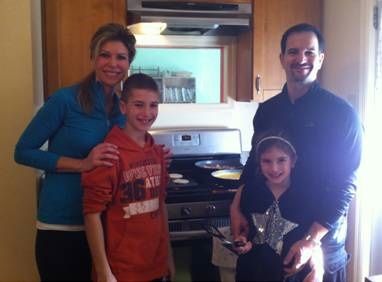Doc Holidays
Physicians spend their lives helping others, but many spend their holidays finding new ways to give back, from dressing up as Santa Claus to raising awareness about cancer through music.

Mark Applefeld, MD, bears little resemblance to Santa Claus.
The director of Cardiology at Mercy Medical Center in Baltimore, MD, is slender and beardless, and lacks the flowing white tresses possessed by the Christmas icon. But for the past 30 years, Applefeld has donned a white beard and wig, as well as the traditional red with white trim outfit, and been Santa to hundreds if not thousands of children and their families.
“The thing that I think touches me the most is when these little ones, somewhere between 4 and 7, they sit on your lap, and they say, ‘I love you Santa,’” Applefeld says. “You give them a hug, and you just hold onto them for dear life.”
Giving back, particularly during the Thanksgiving and Christmas seasons, is what makes Applefeld and other physicians very special Doc Holidays.
Three decades of Santa
Thirty years ago, Applefeld and his colleagues identified a nearby mission that served approximately 30 children from area families. A spouse of a Mercy employee built a puppet stage, and Applefeld dressed as Santa for the first of many personal appearances. He even had a sleigh, courtesy of Mercy’s wood shop, which he still uses today.
“We had gifts for the kids, some that we bought and others that the hospital contributed,” Applefeld recalls. “It was a feeling that, this was their Christmas.”
Two years later, wanting to serve even more children, the event—dubbed the Cardiac Kids Holiday Party—was moved to Mercy, where it has been a pre-Christmas staple ever since. Between 80 and 100 children and their families attend the event each year. Arrangements are also made to deliver gifts to those who are unable to attend.
Mercy staff as well as patients donate the gifts, which range from clothing to stuffed animals and toys.
“We don’t ask people who donate to spend hundreds of dollars,” Applefeld explains. “I think each person who’s buying things for the kids is spending around $30 to $40. And they know the ages of the child of the family they’re supporting, so we sort of leave it up to the individuals as to what they want to purchase.”
The annual event begins around 11 a.m. and runs for 4 hours. There are face painters and magicians, as well as carolers who lead everyone in song. But the highlight is when Applefeld dressed as Santa Claus rides in on his sleigh.
“I have a pillow stuffed into my clothing,” he says. “And the question I get asked most is, ‘Are you really Santa?’”
Applefeld is not Christian, but he maintains that the event provides a sense of what the holidays are truly about. And while those feelings never get old, Applefeld, unfortunately, is getting older.
“I’m in my 70s, so there will probably come a time when I say, ‘Look, it’s time for somebody else to do this,’” he acknowledges. “But I would love to continue for as long as I am able. It gives you a nice feeling; that maybe the world isn’t as crazy as it seems.”

If it’s Thanksgiving morning, it’s a sure bet where James Marotta, MD, FACS, will be. The dual board certified facial plastic surgeon from Long Island, NY, together with his wife and 2 children, Noah and Gillian, will be at the Suffolk County Coalition Against Domestic Violence Shelter making breakfast for those families in need.
“It’s a really heartwarming experience,” Marotta explains. “Showing my kids a sense of service, a sense of gratitude for what they have. Just the joy of interacting with the young children who are in transition, in a shelter situation.”
Marotta’s association with the Thanksgiving morning tradition grew out of his membership in the American Academy of Facial Plastic and Reconstructive Surgery’s FACE to FACE program, a humanitarian and educational surgical exchange initiative. Throughout the year he volunteers his time and surgical expertise to help victims of domestic abuse with facial injuries.
“When I enrolled in [the FACE to FACE program], I treated a patient who was a victim of domestic violence who had lots of scar tissue in her lips as a result of punches she received,” he explains. “I found [helping] really rewarding, and wanted to treat similar patients. That’s when I contacted the Suffolk County Coalition Against Domestic Violence.”
Treating patients expanded into fundraising for the organization, and helping to raise awareness of domestic violence.
“I feel the need to give back,” Marotta says, “and be involved in my community.”
Marotta isn’t certain if his children grasp the seriousness of the situation facing the displaced families at the domestic violence shelter, but he’s fully cognizant of their desire to help. Not only do they enjoy helping to cook the breakfast, it was their idea to bring some of their own belongings to give to the children.
“They told me, ‘They (the children at the shelter) don’t have toys. We have some toys, dad, that we’re a little too old for. Can we bring those down there?’ So that’s what we did. And you know, we learned as much from them as we were showing them.”
The letters of appreciation from the families as well as the organization make it all worthwhile. And through it all, Marotta keeps his emotions in check.
“It’s the realization that anybody can end up in that situation,” he explains. “There are too many gray zones and life is too complicated to be self-righteous and have a sense of anger. There are a lot of different reasons why those situations occur, and I feel badly for those people. So this is definitely a tradition we’re going to continue.”

Taraneh Shirazian, MD, will be home for the holidays this year, but she will be extremely busy. That’s because Shirazian, who is the director of global women’s health at New York’s Mount Sinai Hospital and assistant professor of obstetrics, gynecology and reproductive medicine at the Icahn School of Medicine, and her team of volunteers will be preparing birth and prenatal kits for women in Guatemala and Kenya in order to ensure a safe and sanitary delivery. The kits—containing, among other items, a pair of gloves, a bar of soap, a mat for the woman, a baby hat and blanket—will be distributed in January 2015 by Shirazian and her team.
“No woman should die giving life,” Shirazian says. “The best present I can give during the holidays is a birth kit that will change the life of a mother and her infant.”
Shirazian’s efforts are not limited to holiday time. She has run Saving Mothers, a 501(c)(3) nonprofit which she co-founded, since 2009. Since its inception, the organization has had a tremendous impact on developing areas such as Guatemala and the Dominican Republic. Shirazian and her team travel to these areas in order to improve the health outcomes of mothers and babies, and to teach women how to safely deliver babies while keeping the mothers alive and healthy.
“I think what motivated me the most is, as an OB/GYN who had the opportunity to be in many communities globally, I was always very horrified by the disparities in care that women get in parts of the world where there’s no access to healthcare providers,” Shirazian explains. “I think that what many people don’t realize is that all of the doctors in the world are really concentrated in the western hemisphere. The rest of the world has very few skilled providers; very few highly trained specialists that can offer them the kind of care that is often needed.”
One of Saving Mothers’ big efforts is taking the tools commonly used in the US to protect expectant mothers from death and complications translate them to the low-resource settings. For example, a tool called a pre-term birth indicator helps determine a woman’s risk of going into pre-term labor. Shirazian and her team will use this tool to triage women who are at high risk and, once identified, keep them in maternity waiting homes at the hospital rather than have them make the three-day trip back home, thus preventing a pre-term complication.
“We’re going to look at using this tool in a low-resource setting,” she says. “No has ever done this before, and the whole point is we’re hoping that we’ll be able to pick up the women who are at more risk so that we can treat them differently than the general population.”
Shirazian says the people of these communities are extremely grateful, and that gratitude helps serve as motivation for them to help their fellow women, enabling the program to have far-reaching impact. And Shirazian’s message to them is simple.
“When they express their gratitude, I just to them to pay it forward,” she says. “Just give back to the other women in the community. Reach out to them. Motivate and empower them, because that’s how whole communities grow and become better.”

Nimesh Nagarsheth, MD, will be in New York City this holiday season. So will a lot of other people? True, but Nagarsheth, a gynecological oncologist and minimally invasive/robotic cancer surgeon at Mount Sinai Hospital will be there helping to save women’s lives not just through his work as a doctor, but through his work as a rock musician.
In 2008, Nagarsheth, an established musician and percussionist, joined five other women’s cancer surgeons from around the country for what he thought was a one-time event to raise awareness of gynecologic cancers through music. But the response to their music was tremendous, and they ended up forming the band N.E.D., which stands for No Evidence of Disease. Their latest fundraising effort takes place on December 11 in the Big Apple.
“We picked that particular date intentionally,” Nagarsheth says. “We tried very hard to find a venue that could accommodate us for that specific week that we wanted to do it, because there’s something magical about New York City in the winter time, and the holiday time. And, I wanted to capture that magic into our performance and have that backdrop of New York City during the holiday season. People tend to be more giving at that time, for fundraising purposes.”
The impact of N.E.D.’s music has been far-reaching. The band has released 2 studio albums, and has been featured in a documentary film, “No Evidence of Disease,” as a nonprofit endeavor to raise awareness for women’s cancers and the healing powers of music. And Nagarsheth received an offer to write a book on music and cancer. Titled “Music and Cancer: A Prescription for Healing,” (Jones & Bartlett Learning, 2009), the book gave Nagarsheth an opportunity to explore the parallels that exist between music and medicine.
“We can take information from those parallels that exist and help our patients understand cancer care better, and maybe improve their quality of life by understanding these concepts,” he says. “And it worked. On a weekly basis, patients are telling me that the concepts in the book and all these ideas that have come out with this music and cancer project have been of tremendous help to them in coping with their disease and moving forward and improving their quality of life.”
Nagarsheth and his band mates were recently invited to Capitol Hill to play in the capitol building for members of Congress, who were also able to screen the documentary film. Members of Congress also engaged in a Q&A session with the physicians—all aimed at raising awareness and education for women’s cancers.
“I can’t tell you how cool that was,” Nagarsheth admits.
Looking back on all that has transpired since that one-time show for colleagues six years ago, Nagarsheth says, “Never in a million years did we imagine it would turn into what it is today.”
